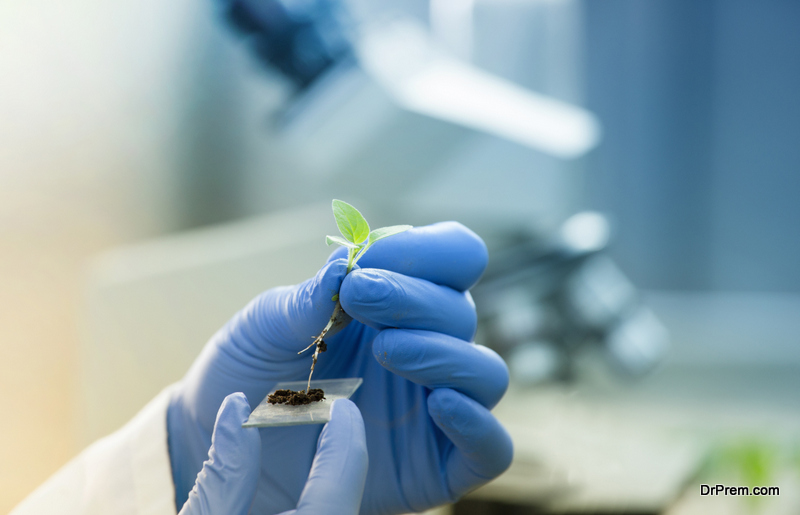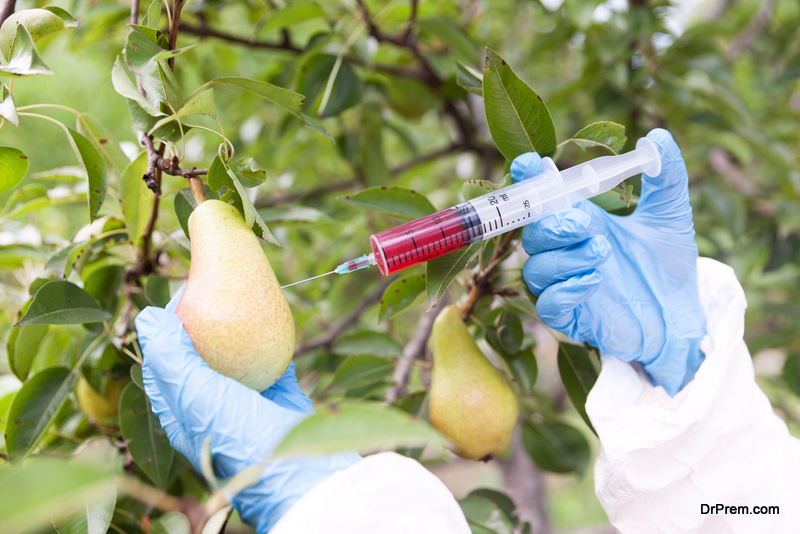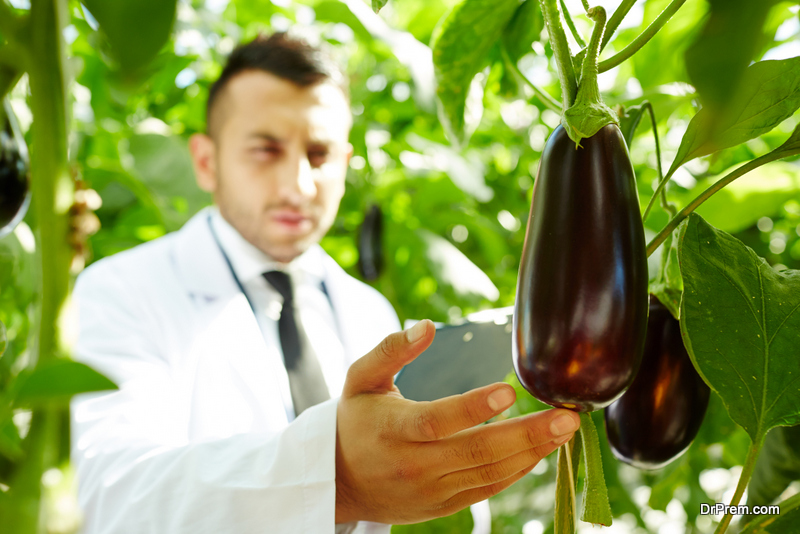At present, the human population of the Earth is 6.5 billion. By the year 2050, the human population is expected to become 9.5 billion. Human beings have relied on farming and agriculture to get essential foods like grains, vegetables and crops. Essential non-food items like cotton and jute are also obtained through agriculture.
 Farming has a significant environmental impact, and one way for ensuring global sustainability of farm produce is addressing the environmental impact of farming and taking effective measures to reduce them.
Farming has a significant environmental impact, and one way for ensuring global sustainability of farm produce is addressing the environmental impact of farming and taking effective measures to reduce them.
Dependence of a large population for food and other essentialities on the limited arable land of the earth is causing severe environmental impacts. For farming and agriculture, forest land needs to be cleared for sowing the crops. In earlier times when the human population wasn’t too much, farming practices were contained within the ecosystem that humans had established with earth’s habitation and resources. The alarming rate of human population growth is creating ecosystem disbalances.
GMO and environmental impact of farming
 As per the environmentalists increasing the arable land any further is not feasible. Data on environment clearly show that earth is already being cropped to the hilt. Clearing the already depleting green cover for more cropping will seriously disturb the planet’s biodiversity and ecosystem. Hence based on supporting evidence the environmentalists have recommended the best use of available arable land.
As per the environmentalists increasing the arable land any further is not feasible. Data on environment clearly show that earth is already being cropped to the hilt. Clearing the already depleting green cover for more cropping will seriously disturb the planet’s biodiversity and ecosystem. Hence based on supporting evidence the environmentalists have recommended the best use of available arable land.
GMO crops have been associated with several pros and cons. GM crops are sold through commercial channels to farmers worldwide and are at present being planted in six continents on more than forty million hectares of land. Leading environment science journals have talked about the advantages of GMOs as well as the negative effects of GMOs. Environment scientists support the view that good GMO cropping practices can alleviate the environmental impact of farming in major ways.GMO farming needs to be adopted in ways that maximise advantages of biotech cropping while keeping their negative effects at bay.
Advantages of biotech cropping
 Worldwide cropping with GMO has brought out several advantages of GMOs that can significantly reduce the environmental impact of farming. Global data on biotech cropping report the following advantages of GMOs:
Worldwide cropping with GMO has brought out several advantages of GMOs that can significantly reduce the environmental impact of farming. Global data on biotech cropping report the following advantages of GMOs:
- Genetic modification can make the crop resistant to disease-causing insects and viruses leading to less crop produce spoilage.
- Genetic modification can make the crop resistant to herbicides which farmers need to use to terminate unwanted weeds or vegetation.
- The biotech or GMO cropping data of 1996-2006 showed a reduction in pesticide spraying by 671.2 million Kg.
- GMO can reduce pesticide-related environmental footprint by 18.4%.
- Biotech cropping has been shown to largely reduce agricultural greenhouse gas emissions (equal to the removal of 16.75 million plying cars or 27 billion kg of CO2 from the atmosphere).
- GMO has been shown to decrease usage of chemical pesticides by 37%.
- Biotech cropping has enabled soil conservation in the US (1 billion annually) through cropping practices of no-till cultivation and continuous expansion of conservation tillage.
- GMO cropping data of US and Australia cotton fields show an increase in beneficial insect biodiversity count.
Commercial tree plantation with genetic modification
 Trees are planted at commercial plantation sites to get paper from the tree wood. Genetic modification of tree lignin yield woods that do not require large quantities of chemicals for being processed into pulp. The paper manufacturers can thus get the pulp without using the harsh chemicals for making paper. The paper making industry is a large industry and modified lignin has the scope of environment protection by saving the usage of harsh chemicals on large global scales.
Trees are planted at commercial plantation sites to get paper from the tree wood. Genetic modification of tree lignin yield woods that do not require large quantities of chemicals for being processed into pulp. The paper manufacturers can thus get the pulp without using the harsh chemicals for making paper. The paper making industry is a large industry and modified lignin has the scope of environment protection by saving the usage of harsh chemicals on large global scales.
Possible negative effects associated with biotech cropping
 Many concerns have been raised by environmental scientists who want to caution the world against indiscreet adoption of GMO cropping. A GMO crop is a genetically modified crop and introducing a GMO seed or plant in an arable area can impact the surrounding biodiversity in a major way.
Many concerns have been raised by environmental scientists who want to caution the world against indiscreet adoption of GMO cropping. A GMO crop is a genetically modified crop and introducing a GMO seed or plant in an arable area can impact the surrounding biodiversity in a major way.
A lab study on GMO has shown that feeding on GMO can potentially harm monarch butterflies. The biodiversity comprises microbes, insects and flora and fauna. Some scientists have opined that it is not possible to assess the long term impact of the spread of genetic substances present in the GMOs into the soil and air through the microbes, insects and plants. Some GMOs have shown a propensity for generating new weed types by out crossing or mere survival in the wilderness.
Best practices in GMO cropping
Scientists advocate the discreet use of GMO crop since GMO cropping has both its pros and cons. Environmentalists support commercial availability of only those GM crops that have gone through the well-defined evaluation process.
Before being made available in the markets, the GM crops need to qualify the conditions defined by the local and global regulatory authorities. Environmental effects of GM crop have to be assessed at the local levels as well. The local data need to be aggregated with global GM regulatory authority data. The specific local reports and data available on GM crops need to take into consideration the local environmental conditions in which the GM crop was grown.
Whether or not the GM crop will be safe in other environments need to be worked out with care before being released into other local markets.
The GM crops are assessed rigorously on the following parameters before being released commercially:
- The effect of GM crop matter on organisms that feed on or pollinate with the GM crop.
- The survival capacity of GM crop in a specific environment.
- The growth pattern of the GM crop (whether eco invasive or eco-friendly).
- The possibilities of gene flow and consequences.
Conclusion
GMO has shown to have several major beneficial effects on the environment as well as economic advantages. The high survivability of GM crops and resistance towards harmful microbes and insects minimises crop production losses. GM crops can maximise arable land use and conserve soil.
Advantages notwithstanding, Biotech cropping cannot be the panacea towards reducing the environmental impact of farming. GMO has come under several controversies due to possible harmful effects on biodiversity and the ecosystem. Only certified and tested GMO crops are recommended for plantations. The GM industry needs to be always locally and globally interconnected and regulated to ensure safe growing of GM crops.




